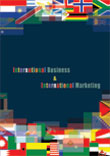International Business and International Marketing
 |
Details
Textbook:
Pages : 328;
Paperback;
210 X 275 mm approx.
Suggested Case Studies
Workbook:
Pages :
280; Paperback;
210 X 275 mm approx, Sample Applied Theory Questions
Sample Multiple Choice Questions (Online Quiz)
Pricing
Textbook Price: Rs. 750;
Workbook Price: Rs. 700;
Available only in INDIA
Buy Now
Please allow 5 to 10 days for delivery.
Detail Table of Contents
Entry Strategies in International Markets : Chapter 6
SUMMARY:
In the present era of globalization, many firms do not confine themselves to their domestic market but choose to enter international markets at some point. There are two modes for entry into international markets. These are: low or shared and the high or full control modes. Firms entering international markets should make a careful study of the pros and cons of each entry mode.
|
|
The choice of the entry mode depends on a set of internal and external factors relating to the firm. The social ties of a firm also affect the choice of entry mode choice for the firms. Firms which interact with different groups, get information very easily. Firms often prefer to do business with acquaintances in foreign markets or with parties who are introduced by their common friends. After choosing the entry mode, the right timing for entry into the international markets is critical.
The factors that are specific to a firm, industry and to the host country will have a combined influence on the timing of the firm's entry. Japanese firms usually take a long term perspective when entering foreign markets. They prefer a high control mode of entry. The stake of the firm, risk factors, resource commitment, need for local contribution, and government regulations are the five important factors that influence the entry mode decision of a Japanese firm. In general, all high-tech start-up companies prefer a low entry mode.
Only in rare cases do they opt for a high control mode. Firms, which sell customized products, usually adopt a direct exporting strategy whereas firms that sell standardized products prefer to have intermediaries. In countries where the risk factor is high, firms adopt a low control entry mode and in economies where the risk factor is low, a high control entry mode is preferred. The entry strategies of pharma companies can take five forms - exporting, licensing, joint venture, mergers and acquisitions, and establishing a subsidiary of their own. The decision regarding the mode of entry in the pharma industry is basically guided by the objectives of the firms concerned.



